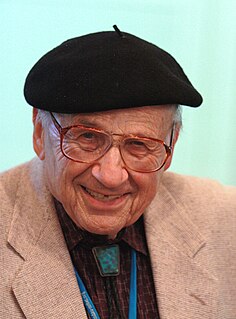The American Physical Society (APS) is a not-for-profit membership organization of professionals in physics and related disciplines, comprising nearly fifty divisions, sections, and other units. Its mission is the advancement and diffusion of knowledge of physics. The society publishes more than a dozen scientific journals, including the prestigious Physical Review and Physical Review Letters, and organizes more than twenty science meetings each year. APS is a member society of the American Institute of Physics. Since January 2020 the organization is led by chief executive officer Jonathan Bagger.
Physical Review is a peer-reviewed scientific journal established in 1893 by Edward Nichols. It publishes original research as well as scientific and literature reviews on all aspects of physics. It is published by the American Physical Society (APS). The journal is in its third series, and is split in several sub-journals each covering a particular field of physics. It has a sister journal, Physical Review Letters, which publishes shorter articles of broader interest.

Walter Kohn was an Austrian-American theoretical physicist and theoretical chemist. He was awarded, with John Pople, the Nobel Prize in Chemistry in 1998. The award recognized their contributions to the understandings of the electronic properties of materials. In particular, Kohn played the leading role in the development of density functional theory, which made it possible to calculate quantum mechanical electronic structure by equations involving the electronic density. This computational simplification led to more accurate calculations on complex systems as well as many new insights, and it has become an essential tool for materials science, condensed-phase physics, and the chemical physics of atoms and molecules.

Michael S. Turner is an American theoretical cosmologist, who coined the term dark energy in 1998. He is the Bruce V. & Diana M. Rauner Distinguished Service Professor at the University of Chicago, and was formerly the Assistant Director for Mathematical and Physical Sciences for the US National Science Foundation from 2003–2006. His book The Early Universe, co-written with fellow Chicago cosmologist Rocky Kolb and published in 1990, is a standard text on the subject.

Leo Philip Kadanoff was an American physicist. He was a professor of physics at the University of Chicago and a former President of the American Physical Society (APS). He contributed to the fields of statistical physics, chaos theory, and theoretical condensed matter physics.
Malcolm Roy Beasley is an American physicist. He is Professor Emeritus of Applied Physics at Stanford University. He is known for his research related to superconductivity.
Eugen Merzbacher was an American physicist.
William Allan Bardeen is an American theoretical physicist at Fermi National Accelerator Laboratory. He is the son of John Bardeen and Jane Maxwell Bardeen.
G. Norris Glasoe was an American nuclear physicist. He was a member of the Columbia University team which was the first in the United States to verify the European discovery of the nuclear fission of uranium via neutron bombardment. During World War II, he worked at the MIT Radiation Laboratory. He was a physicist and administrator at the Brookhaven National Laboratory.
Patrick A. Lee is a professor of physics at the Massachusetts Institute of Technology (MIT).
Samuel Colville Lind was a radiation chemist, referred to as "the father of modern radiation chemistry".
Gary S. Grest is an American computational physicist at Sandia National Laboratories.
Homer Dupre Hagstrum was an American physicist who specialized in surface physics.
Arkady Vainshtein is a Russian and American Professor Emeritus of Theoretical physics who was awarded Pomeranchuk Prize (2005) and Sakurai Prize (1999) for theoretical physics.
Mikhail "Misha" Voloshin was a Russian and American theoretical physicist. Voloshin graduated from physics class of Moscow School 57 in 1970. Voloshin started working at ITEP in 1976 and accordingly earned his Ph.D. in 1977. In 1983 he received a Soviet medal and an award in physics. Beginning in 1990, he taught quantum physics at the William I Fine Theoretical Physics Institute, a division of the University of Minnesota College of Science and Engineering. In 1997 elected a fellow of the American Physical Society. In 2001 he was awarded J.J. Sakurai Prize for Theoretical Particle Physics and in 2004 he was awarded the Alexander-von-Humboldt Award.
Keith Alison Olive is a theoretical physicist, and director at the William I Fine Theoretical Physics Institute, University of Minnesota, specializing in particle physics and cosmology. His main topics of research are: big bang nucleosynthesis, which is an explanation of the origin of the light element isotopes through 7Li; particle dark matter; big bang baryogenesis, which is an explanation of the matter-antimatter asymmetry observed in nature; and inflation which is a theory constructed to resolve many outstanding problems in standard cosmology.
Kurt Kremer is a German physicist.
Joseph Anthony Zasadzinski, also known as "Joey Z" is an American chemical engineer from the University of California, Santa Barbara. He was awarded the status of Fellow in the American Physical Society, after he was nominated by his Division of Biological Physics in 2008, for "applying physical principles of self-assembly, directed assembly and bio-mimicry to create well-controlled lipid structures such as unilamellar vesicles and "vesosomes" for biomedical applications such as targeted drug-delivery vehicles and treatments for respiratory diseases, and for developing new microscopies." Zasadzinski currently works in the Department of Chemical Engineering and Materials Science at the University of Minnesota, Twin Cities.
Lucy Frear Fortson is an American astronomer known for her work on gamma-ray astronomy and Galaxy morphological classification and for her leadership of citizen science projects including the Galaxy Zoo and Zooniverse. She is a professor in the School of Physics and Astronomy at the University of Minnesota.
Alexandre Lazarian is an astrophysicist. He is a professor of astronomy at the University of Wisconsin–Madison with a joint appointment at the Department of Physics. He is a fellow of the American Physical Society.


